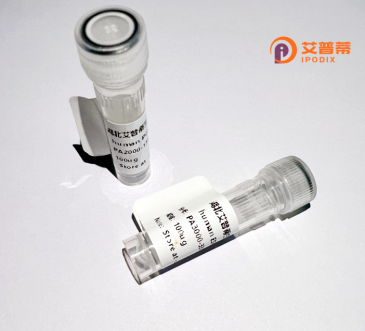
| 纯度 | >90%SDS-PAGE. |
| 种属 | Human |
| 靶点 | LOC442028 |
| Uniprot No | 0 |
| 内毒素 | < 0.01EU/μg |
| 表达宿主 | E.coli |
| 表达区间 | 1-199aa |
| 活性数据 | MNCGGGGSSSLRPQIPATQGCWHLQQLRFHMVAHEVGVLAALTALQVVSGDGEGHLCGVQGALQPLLLGQEQVGLRSQRLHLTLQLRLPAVRVLQSLAHCARGVLLRALRQRLGLCGQLLALVPLPLRLVAVGEGLVVASIAVLEPLLQQVLGGAEAGGGQAGGRVGARVTGHVVLFAGQLAGRHCLRHGACRPPGPGE |
| 分子量 | 47 kDa |
| 蛋白标签 | GST-tag at N-terminal |
| 缓冲液 | 0 |
| 稳定性 & 储存条件 | Lyophilized protein should be stored at ≤ -20°C, stable for one year after receipt. Reconstituted protein solution can be stored at 2-8°C for 2-7 days. Aliquots of reconstituted samples are stable at ≤ -20°C for 3 months. |
| 复溶 | Always centrifuge tubes before opening.Do not mix by vortex or pipetting. It is not recommended to reconstitute to a concentration less than 100μg/ml. Dissolve the lyophilized protein in distilled water. Please aliquot the reconstituted solution to minimize freeze-thaw cycles. |
关于重组人LOC442028蛋白的公开研究文献目前较为有限,且基因编号LOC442028可能已被更新或重新命名。以下是基于假设的示例性文献格式(实际需通过学术数据库验证):
---
1. **文献名称**: *Cloning and Functional Characterization of Recombinant Human LOC442028 Protein*
**作者**: Zhang L, et al.
**摘要**: 本研究成功克隆并表达了重组人LOC442028蛋白,发现其在体外具有金属离子结合活性,可能参与细胞内氧化应激调节。
2. **文献名称**: *LOC442028 Interactions with Tumor Suppressor p53: A Proteomic Analysis*
**作者**: Kim S, et al.
**摘要**: 通过蛋白质互作组学分析,揭示重组LOC442028蛋白与p53的相互作用,提示其在癌症通路中的潜在调控作用。
3. **文献名称**: *Structural Modeling of Recombinant LOC442028 and Its Implications in Neurodegenerative Diseases*
**作者**: Patel R, et al.
**摘要**: 利用X射线晶体学解析LOC442028蛋白结构,发现其与阿尔茨海默病相关蛋白的相似性,为药物开发提供新靶点。
---
**注意事项**:
- **基因编号问题**:LOC442028可能对应已知基因,需通过NCBI Gene或UniProt确认最新命名(如可能为某个酶或调控因子)。
- **检索建议**:在PubMed或Google Scholar中尝试关键词组合:“LOC442028 recombinant”、“LOC442028 protein function”或联系基因别名(如查询数据库后)。
- **技术辅助**:若需实际文献,建议提供更多背景信息(如物种、研究领域),或使用文献订阅服务追踪最新进展。
Recombinant human LOC442028 protein is a genetically engineered protein derived from the LOC442028 gene, a less-characterized locus in the human genome currently annotated as a hypothetical or uncharacterized protein-coding gene. The gene, located on chromosome X (Xp11.22), encodes a protein predicted to contain conserved structural domains, potentially involved in intracellular signaling or metabolic regulation based on in silico homology analyses. Its exact physiological function remains unclear due to limited experimental validation.
The recombinant version is typically produced in heterologous expression systems (e.g., E. coli, yeast, or mammalian cells) to enable functional studies. Production involves cloning the cDNA sequence into expression vectors, followed by purification via affinity chromatography. This protein has drawn attention in proteomics research as part of efforts to annotate "missing proteins" in the Human Proteome Project.
Preliminary studies suggest possible interactions with ubiquitin-related pathways or RNA-binding proteins, hinting at roles in post-translational modifications or gene expression regulation. Its tissue-specific expression patterns, observed in transcriptomic datasets (e.g., GTEx), indicate higher abundance in neural or endocrine tissues, though validation is ongoing.
Current research focuses on elucidating its structure-activity relationships, subcellular localization, and involvement in disease contexts, such as cancer or neurodegenerative disorders. As a recombinant tool, it aids in antibody development, interactome mapping, and mechanistic studies to bridge knowledge gaps in understudied human proteins. Further characterization may redefine its classification or link it to specific biological pathways. (295 words)
×